Zadar, a small city on the coast of Croatia, boasts it is home to the “tastiest tuna in the world.” It IS very good; in fact, it was far and away my favorite among an assortment of five seafood dishes that comprised most of a dinner (actually, banquet) staged last month by the Zadar Tourist Board at the famed Delmonico’s restaurant in downtown Manhattan.
The Zadar area is known for Bluefin tuna that is bred in very large cages and highly valued around the world, especially in Japan. For our dinner plates, it had been briefly seared and was served with chicory cream, cucumber marinated in lime, parsley oil and fish sauce. So simple, it seems, but there is not a chance on earth that I could make that at home.
Zadar, a city of about 71,000, laid on the dinner spread in partnership with the Croatian National Tourist Board. The sponsors, in workshops as well as social events, were promoting their wares to U.S. travel professionals, including travel journalists. Which is how I came to be on the guest list.
For someone who grew up in landlocked America, the amount of seafood (five of six courses preceding dessert) was very impressive indeed. But then, Zadar faces the Adriatic Sea, a very good place to grow up whether you are human or fish.

Kayaking on the Adriatic Sea, with Zadar in the background.
The city is on the northern Dalmatian Coast but doesn’t get the attention that the better known Dubrovnik and Split receive.
Our feast was accompanied by a short presentation meant to explain why Zadar deserves more attention. In my case, it was a refresher course because I visited the city 10 years ago; I still have my contemporaneous stories, a diary and photos. In 2013, I was traveling on a travel agent familiarization tour (i.e., a learning tour), which meant our group visited as many places as possible in a very short time.
Zadar boasts a long history — some 3,000 years. The Romans were there, of course; they were everywhere. Sadly, Zadar’s Roman remains are minimal.
But, the city’s Old Town, through its churches and UNESCO-protected city walls, provides a glimpse of the medieval city.
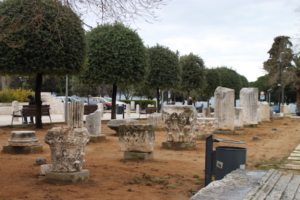
Above, remains of a Roman Forum in Zadar’s Old Town.
Below, the ninth century St. Donat Church, built using stones from the ruined Roman Forum. The bell tower associated with the 12th/13th century Zadar Cathedral is at right.

Oddly, the part I remembered best was the newest thing — something called the Sea Organ. The name suggests seafood, but oh no. It’s not that.
The Sea Organ is an underwater musical instrument installed in the Old Town in 2005. Situated under marble steps that descend into the Adriatic Sea, its pipes blow notes in random order, determined by the movement of the sea. If the waters are still, there is no sound; if waters are rough, the music is loud. As I listened, the music didn’t sound all that random, but positively melodic.
The same architect, Nikola Basic, also created Zadar’s Monument to the Sun, a large sidewalk-level circle of solar-powered cells that collect their energy by day and return the energy at night with a multicolored light display.
During my group’s daytime visit, we walked across the circle, which is the centerpiece of an open plaza near the sea (and near the Sea Organ). But our group left town too soon to see the Monument to the Sun deliver its after-dark payoff.
More about that Old Town
Zadar’s pedestrian-only Old Town is set on a small peninsula that parallels the mainland, and it still uses the street plan laid out by the Romans who arrived there in the second century B.C.
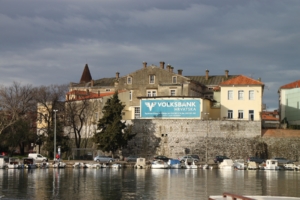
View of walls surrounding Zadar’s Old Town — with a 21st century advertiser’s billboard. The Old Town sits on a peninsula. Water in the foreground is the natural harbor located between that peninsula and mainland Zadar.
The remains of Roman columns sit at the site of the Forum, as do a few churches. The Forum was active until the third century. In the sixth century, it was destroyed in an earthquake.
The oldest of the churches is the ninth century St. Donat Church, built using some of the Roman stones; it is now a concert hall.
My group walked into the city’s cathedral, which dates from the 12th and 13th centuries. The top level of the church was destroyed in World War II and the rebuilt sections were easy to pick out.
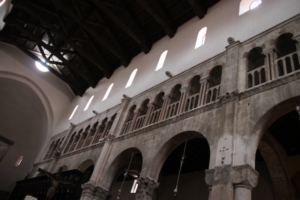
Interior of the Zadar Cathedral, where smooth-surfaced walls at the top reveal the portions that were destroyed during World War II and rebuilt after.
Just before entering the cathedral, our local guide advised that we were forbidden to take photos inside, adding she was obliged to tell us that. I understood that latter remark as a cue that I could take sneak shots, so I did.
The city’s medieval walls (also from the 12th and 13th centuries) provided a pretty — and photogenic — backdrop to the natural harbor between the Old Town peninsula and mainland Zadar. Numerous small boats, often pleasure vessels, further enhanced this scene.
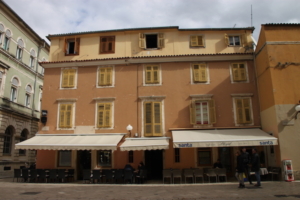
Business establishments in the heart of Zadar and near the cathedral.
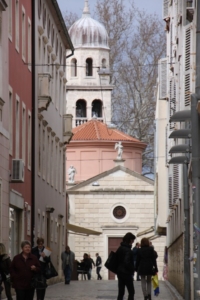
A side street in Zadar’s Old Town, leading to one of the historic area’s several small churches
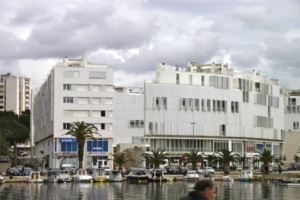
Above, modern additions to the Zadar streetscape, found near, but not inside, the Old Town. Below, for something else in the newer category, but with very old antecedents, Zadar boasts a small sphinx, seen in a local park. It dates from the early 20th century.
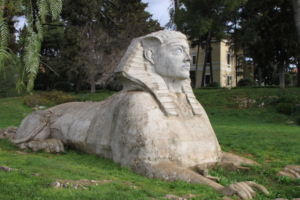
More about that food
My diary says we had a “very nice” dinner in Zadar, but I don’t remember details. My diary also tells me our group stopped briefly in a little place called Nin, which, it says, “today is the sanctuary of a tiny church, one of the country’s oldest.” That is the Church of St. Nicholas where, tradition says, seven Croatian kings were crowned.

The tiny Church of St. Nicholas in Nin, Croatia, built on an earthen mound atop unexcavated prehistoric graves. Battlements were added to the top because of danger from the Turks.
But the diary doesn’t mention salt! Maybe because salt in and of itself is not a typical tourist attraction.
Anyway, it turns out that Nin is home to salt fields, where locals have harvested natural salts for 1,500 years. Nin Saltworks bills its product as good for nutrition and health — and packages its finishing salt in round boxes, a few of which turned up on the tables at the Zadar dinner in New York City.

Salt and olive oil, products from the Zadar area.
The chefs ensured we sampled pretty much any specialty food or drink that comes from the Zadar region, including Pag cheese, made on the island of Pag near Zadar; several dinner wines, generally whites; olive oil (bottles of Zadar oils sat on each dinner table, too), and cherries — well, not cherries specifically, but a sweet dessert wine made using marasca sour cherries.
These same cherries are the basis for the Maraschino liqueur, created in a 16th century monastery in Zadar and still made locally. Also, the marasca cherries were the original (and authentic) Maraschino cherries. Although most cocktail cherries these days are soaked in syrup, the first Maraschino cherries, in the 19th century, were soaked in the liqueur of the same name. News to me.
For more information about Croatia, we offer at BestTripChoices.com the following, under the headline, A young old country, https://besttripchoices.com/croatia/
This blog and its photos (all dated 2013 except the last one) are by Nadine Godwin, BestTripChoices.com editorial director and contributor to the trade newspaper, Travel Weekly. She also is the author of “Travia: The Ultimate Book of Travel Trivia.”
